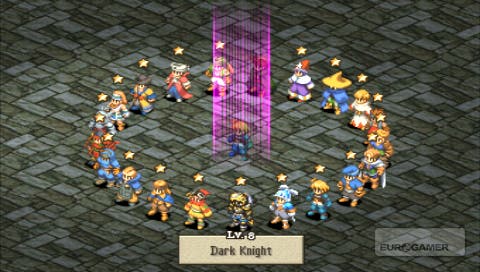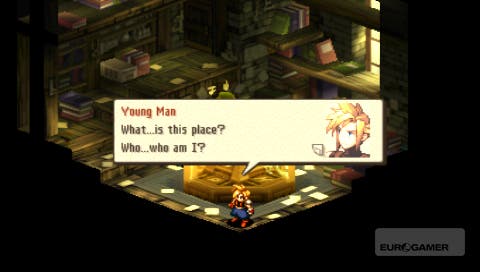Final Fantasy Tactics: The War of the Lions
When two prides go to war - uh!
Final Fantasy Tactics' flexibility is exactly what you'd hope from such a promising system, and that's a large part of why it has remained such an enduring fan favourite for ten years - at one point, commanding genuinely ludicrous sums on eBay for original copies. The potential of the system is almost limitless; imagine our joy upon discovering that combining the Knight's ability to break pieces of enemy equipment with his attack, when applied to an Archer, allowed us to break people's stuff at long range. Beautiful.
A somewhat bittersweet aspect of all this customisation, however, is that it makes you get very attached to the otherwise faceless members of your miniature army. Once any character is knocked out, a count-down appears over their heads, giving you a certain number of turns in which to resurrect them before they're gone for good. While the key storyline characters in the game can't be allowed to die in this manner during battles, your normal grunts certainly can... But once gone, they're really gone.
More than once we've gone back to an earlier save point to try and complete a battle without allowing a favourite soldier to die. There's a real sense of attachment to them, even though they have no dialogue or storyline involvement - and of course, there's a more pragmatic realisation that you've probably customised them to a degree which will take ages to replicate in a fresh recruit from the Guild. No game encourages such obsessive compulsive behaviour to quite the degree that FFT does.
But strategy is interested in you.

One element that has occasionally been criticised about FFT is that its difficulty curve is somewhat peculiar - to put it charitably. This is at once both a fair and an unfair comment to make, because the way you customise your characters means that the curve will never be quite the same for any two players. We certainly encountered some battles that were ludicrously easy, and a couple (especially early on) so hard that we had to re-equip and fight a few random battles before trying again. Everyone seems to share that experience; but everyone seems to find different battles hard or easy.
We would, however, draw attention again to the fact that the game does a minimum of hand-holding in the early stages. Once it's taught you to move around and hit things, you're on your own - aided only by a tutorial that can be accessed at any point, but doesn't really teach you everything you need to know by any means. Keeping an FAQ close at hand isn't really possible with a portable game, so you'll probably find a lot of trial and error goes into your selections early in the game. Perseverance is the key here; within a couple of hours, you'll be flicking through menus like a grizzled veteran of Ivalice.
Despite being a ten year old game from a console most people have consigned to the attic by now, FFT looks fantastic on the PSP. The team's decision to run with hand-drawn sprites for characters and 3D tiles for the background looking more inspired than ever, since the game is one of the few 90s titles that comes bounding across the years looking as gorgeous as it ever has. A wide variety of animations and combat effects deliver a surprisingly impressive looking game that's perfectly suited to the handheld format.

Several tweaks have been made to the PSP edition - two new classes have been added, for a start, bringing the total to 22, along with a new hidden character in the form of Balthier from FFXII (which was set in the same world as FFT, and developed by much of the same team). The most notable change is the addition of brand new rendered videos for key plot points. These are utterly beautiful, presented in a flat pencil drawing style which perfectly complements the in-game sprites and artwork. The translation, too, seems to have been fixed significantly from the somewhat dodgy work on the original PlayStation release, which fans will be relieved to hear.
The presentation of the game is secondary to the game itself, to a large extent - but that doesn't do justice to the fantastic narrative and design on display here. The influences that shaped FFXII are clearly at work, with a story which concerns itself with political machinations and the destiny of the nations of Ivalice as much as it does with the individual characters on the stage. Musically, too, it is magnificent; Nobuo Uematsu may be the composer most closely linked with Final Fantasy, but little of his work on the series touches the elegance and beauty of Hitoshi Sakimoto and Masaharu Iwata's soundtrack for FFT.

Final Fantasy Tactics is the kind of game that hoary old RPG types wax lyrical about to one another for hours, and it justifies every minute. The game may initially be daunting - lacking, perhaps, the sort of finesse that we've come to expect from more modern, user-friendly experiences - but once you're engrossed, it's quite simply one of the most addictive, intriguing experiences you'll ever have.
Gorgeous, complex, well-written and beautifully presented, Final Fantasy Tactics: The War of the Lions has been polished and refined to make it into the best version of one of the best games of the 1990s. For old fans, it's a welcome return for a beautiful game that's been gone ten years; and for those who didn't import, all those years ago, we can only say we're jealous that you get to experience it all afresh.

